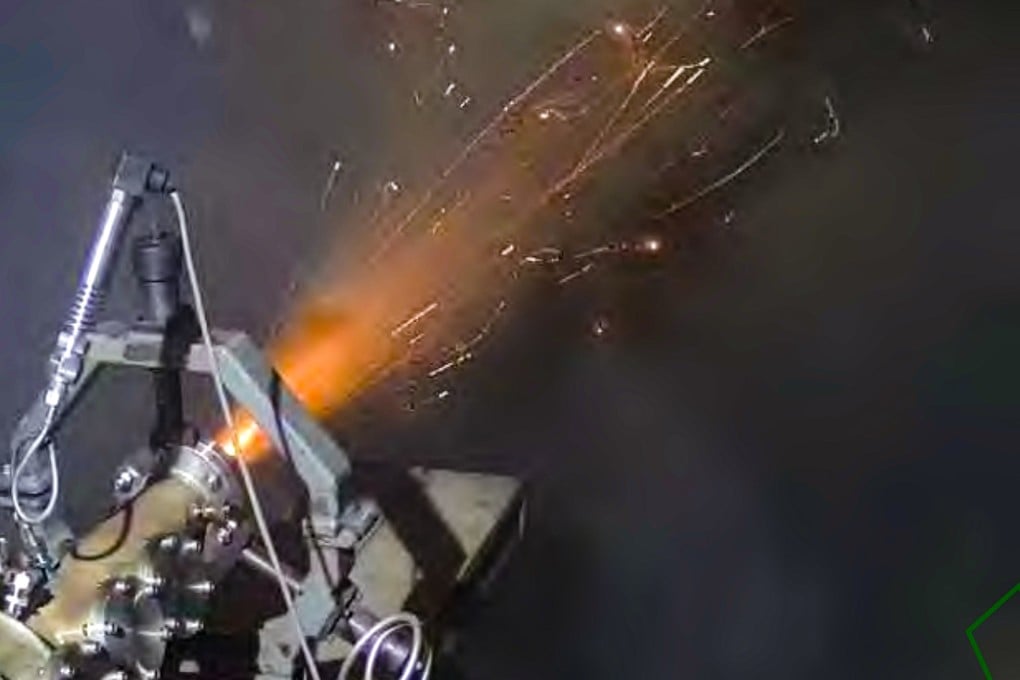Two years after unveiling their ambitious blueprint for a boron-powered propulsion system, Chinese scientists now claim to have successfully developed the “dream engine” that could revolutionize modern warfare.
Initially conceived for hypersonic weapons, the engine has now undergone modifications to operate across multiple environments—flying through the air and diving into the sea to reach targets at incredibly high speeds and over extended distances.
This achievement, as reported in the peer-reviewed Journal of Propulsion Technology last month, confirms the engine’s potential for practical use, according to the Hong Kong-based SCMP.
The breakthrough engine works by inhaling air and water as oxidizing agents, a design that enables its dual functionality.
In laboratory tests, the engine demonstrated a remarkable combustion efficiency of nearly 90% while operating in submarine mode. The tests were carried out in a lab that simulated underwater conditions.

In 2022, the National University of Defence Technology (NUDT) in Changsha, Hunan province, first revealed its blueprint for a boron-based missile propulsion system, as reported by the EurAsian Times at the time.
The team highlighted the transformative potential of cross-medium vehicles powered by this technology. They outlined how these advanced weapons could fly at supersonic speeds for hundreds of kilometers in the air before diving into the water to strike high-value targets such as aircraft carriers, all at speeds exceeding 200 knots.
According to the researchers, no country currently possesses the technology to intercept such versatile and high-speed weapons.
As reported by the South China Morning Post (SCMP), the latest success in engine development signals the potential for transforming modern warfare.
If further testing and deployment of such technology prove successful, it could redefine the landscape of modern warfare, particularly in the realm of hypersonic and cross-medium weapons.
Boron-Powered Engine: A Game-Changer For Modern Weaponry?
Boron, a lightweight element used in scramjet engines – known for their supersonic combustion – is the critical component in this propulsion system. Its unique properties make it ideal for such high-speed, high-efficiency engines capable of pushing the limits of modern weaponry.
When boron comes into contact with oxygen in the air, it ignites with remarkable intensity, rapidly propelling a missile to speeds surpassing five times the speed of sound.
However, Igniting boron in water was a major challenge for Chinese scientists. To solve this, the team created a new design that allowed the fuel to burn more effectively, improving the engine’s efficiency.
They also adjusted the amount of water vapor injected into the combustion chamber and fine-tuned the mix of other ingredients, like magnesium and aluminum. These changes helped the boron burn more completely in the vapor.
While China is making headlines for its development of a boron-powered propulsion system, it is far from the first nation to explore the potential of boron in weaponry.

In fact, the United States Air Force was experimenting with boron-based aviation fuels as early as the 1950s, spurred by intelligence reports that described green flames emerging from the exhaust of a Soviet rocket. This observation led the US military to test the addition of boron to jet fuel with the hope of improving the power of supersonic bombers.
However, the initial foray into boron-enhanced fuels was short-lived. Although boron did indeed increase power output, the Air Force soon abandoned the project.
The ignited boron particles proved difficult to manage, forming a layer of debris within the engine that gradually diminished performance. Moreover, boranes—chemical compounds containing boron—proved to be highly toxic, posing major health risks to personnel working with them.
Those handling the materials had to wear specialized gas masks, and the boron particles themselves were volatile, often igniting spontaneously and in some cases even causing explosions.
In recent years, however, the hypersonic race has reignited interest in boron, with China leading the charge in utilizing the element for high-speed weaponry.
The Chinese military, for example, has developed air-breathing scramjet engines that incorporate solid fuel containing boron nanoparticles. These engines can accelerate missiles to speeds of Mach 5 or faster, a major leap in missile technology.
The US military, too, has ramped up its research efforts in this area. In 2021, NASA, funded by the US Navy, conducted a study that found that boron nitride nanotubes—made by combining boron and nitrogen—could potentially be used to power hypersonic weapons, reaching speeds in excess of 6,400 km/h (4,000 mph).
In 2021, the US Navy also issued a call for proposals to explore “a form of boron or a boron-based chemical pathway” for use in energetic compounds, particularly in fuels, both solid and liquid.
Despite these advancements, most boron-powered engines have been designed primarily for use in the air, focusing on propulsion systems for hypersonic flight. The Chinese innovation, however, stands out for its ability to operate in multiple environments.
If successful, it could reshape the landscape of modern weaponry. The development of an engine that can function both in the air and underwater is a technological breakthrough that gives China an edge in the growing field of multi-modal military systems.
- Contact the author at ashishmichel(at)gmail.com
- Follow EurAsian Times on Google News




